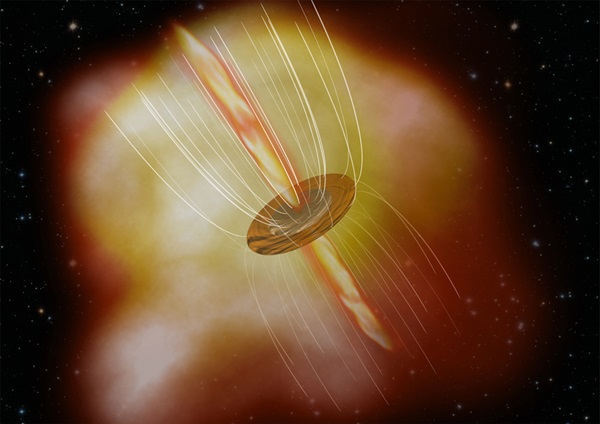Key Takeaways:
A team of astronomers, led by Wouter Vlemmings at Bonn University in Germany, has used the Multi-Element Radio-Linked Interferometer Network (MERLIN) telescope centered on the Jodrell Bank Observatory, in the United Kingdom, to show that magnetic fields play an important role during the birth of massive stars. Magnetic fields are already known to strongly influence the formation of lower-mass stars like our Sun. This new study reveals that the way in which high-mass and low-mass stars form may be more similar than previously suspected.
Massive star — those more than 8 times the mass of the Sun — are crucial to the formation of other stars, planets, and even life. Though rare, they dominate the content and evolution of the interstellar material in the galaxy and are responsible for the production of heavy elements such as iron. However, the question of how massive stars form has proved extremely difficult to answer. The role of magnetic fields in particular has been a topic of great debate. Many scientists thought radiation and turbulence would be the more dominant factors, and hence the formation process of massive stars would be significantly different from that of less massive stars such as our Sun.
“While magnetic fields have been observed in the clouds of molecular hydrogen from which stars form, observations close to massive stars have up to now been in short supply,” said Vlemmings. “If the formation of massive stars is similar to their lighter counterparts, we should be able to detect the strong magnetic fields needed to both produce the jets and stabilize the disks associated with them.”
For the first time, Vlemmings and his collaborators have managed to observe the three-dimensional magnetic field structure around the disk of the massive newly forming star (or protostar) Cepheus A HW2. At a distance of 2,300 light-years from the Sun, Cepheus A is one of the nearest regions where massive stars form, and earlier observations of this region revealed the presence of a disk from which the gas falls on to HW2. In their new observations, the astronomers have found that the magnetic field is surprisingly regular and strong, implying that it is controlling how the matter is transferred through the disk to feed the growing embryonic star.
“Our new technique allows us for the first time to measure the 3-D structure of the magnetic field around a massive protostar. We can see that its structure is surprisingly similar to how we think the field looks when much smaller stars form,” said Huib Jan van Langevelde, director of the Joint Institute for Very Long BaseIine Interferometry (JIVE) in Europe.
To determine the magnetic field structure, the researchers used the MERLIN telescope array to observe radio waves (with a wavelength of approximately 5 cm) amplified by methanol molecules. These methanol molecules, the simplest of the alcohol compounds, are found in regions surrounding the massive disk around HW2 that extend over a region 10 times the size of our solar system. Such regions are called masers because they amplify microwave radiation in the same way a laser amplifies light radiation. Even though a strong magnetic field produces only a weak signature in the signal from the methanol molecules, this amplification is strong enough to make the new work possible.
These new observations will be a cornerstone of one of the first major scientific legacy projects to be carried out with the new e-MERLIN radio telescope network. e-MERLIN is a major upgrade to the MERLIN network that makes it 10 times more sensitive. The legacy project, of which Vlemmings is one of the lead scientists, will use the unique capabilities of the upgraded network to reveal both the magnetic field and the immediate surroundings of many massive protostars of different ages.










